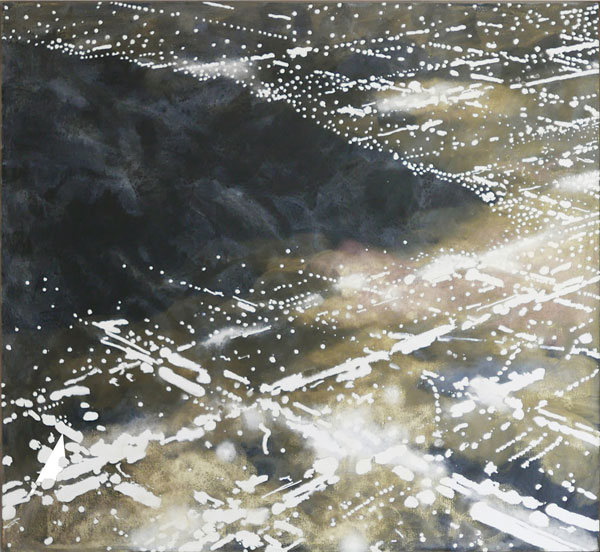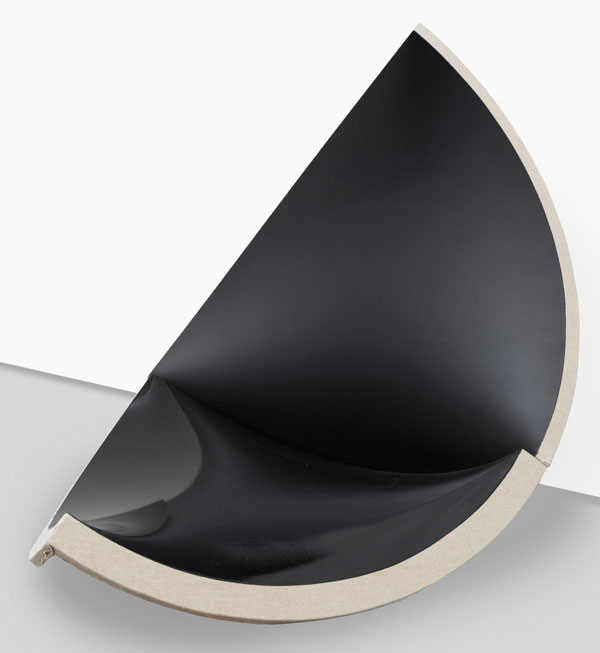Peter Alexander’s true subject has always been light—both in his earlier, luminescent cast-resin sculptures, which he abandoned for several decades for health reasons, and in these captivating LAX series paintings from the 1990s. In the first half of the galleries hang a selection of his larger paintings. Beverly Hills (1990) depicts a darkened hillside jutting out over a sea of gridded lights, the blurred, white beaded lines contrasting with a surrounding landscape that forms hypnotic patterns across the canvas. In a city known for its compartmentalized neighborhoods, Alexander’s opaque aerial vistas of the Los Angeles landscape create a harmonious utopian unification—an equality of place under the night sky.
Artists have long been inspired by nocturnal Los Angeles. Ed Ruscha painted abstracted grids of lights overlaid with text around the same time, and very recently Chimento Contemporary showed Cole Case’s dusk paintings. What distinguishes California native Peter Alexander’s paintings from his contemporaries is his prior artistic process as a sculptor working in the Light and Space movement. His predilection for exploring perceptions of color and light is perhaps most clearly evident in Frannie Frizzle (1991). In the foreground, streaks of an ambiguous red, orange and white hazy substance—smoke or fog, perhaps—begin as sharp, controlled lines moving up from the ground, but as the shapes billow up towards the canvas edges, they taper into streaks and swirls blending with the crimson night, partially obscuring the twinkling lights below.
Through this bird’s-eye view and tilted horizon line, Alexander offers perspective on a rapidly expanding metropolis, which he has undoubtedly watched change over the years. Although painted 25 years ago, the LAX series paintings still feel timely as the city experiences a new wave of rapid construction, environmental considerations, gentrification and other neighborhood changes.
Installed in the other half of the gallery are the intriguing sculptural paintings by Danish artist Jan Maarten Voskuil. Each painting uniquely addresses its own set of formal questions about shape, size, color and dimension, while engaging with the architecture of surrounding space. There are paintings on the walls, directly on the floor, and even wrapping around corners 10-feet above the ground.
Voskuil’s sculptural paintings are firmly rooted in Concrete art, a movement firmly committed to nonreferential abstraction. In Quarter Sphere, Double Depth (2015), Voskuil challenges preconceived assumptions about a painting’s function. A black, wedge-shaped canvas rests on a floor pedestal. The painting’s corners bend and curve concavely upwards toward the viewer in a three-dimensional shape so sculptural that it could easily be mistaken for a different object, a mid-century chair even, if not for the exposed stretcher bars and glued fabric visible from the side.
There are interesting parallels between the two artists. Both Voskuil’s and Alexander’s works bridge the divide between the two disciplines of painting and sculpture. Voskuil’s first visit to Los Angeles was just three years ago, but West Coast culture immediately influenced his subsequent work, while Alexander’s timeless LAX series paintings provide a beautiful, cautionary tale of the urban landscape’s past and future topographies.



